FIAT FREEMONT 2016 1.G Workshop Manual
Manufacturer: FIAT, Model Year: 2016, Model line: FREEMONT, Model: FIAT FREEMONT 2016 1.GPages: 412, PDF Size: 3.36 MB
Page 51 of 412
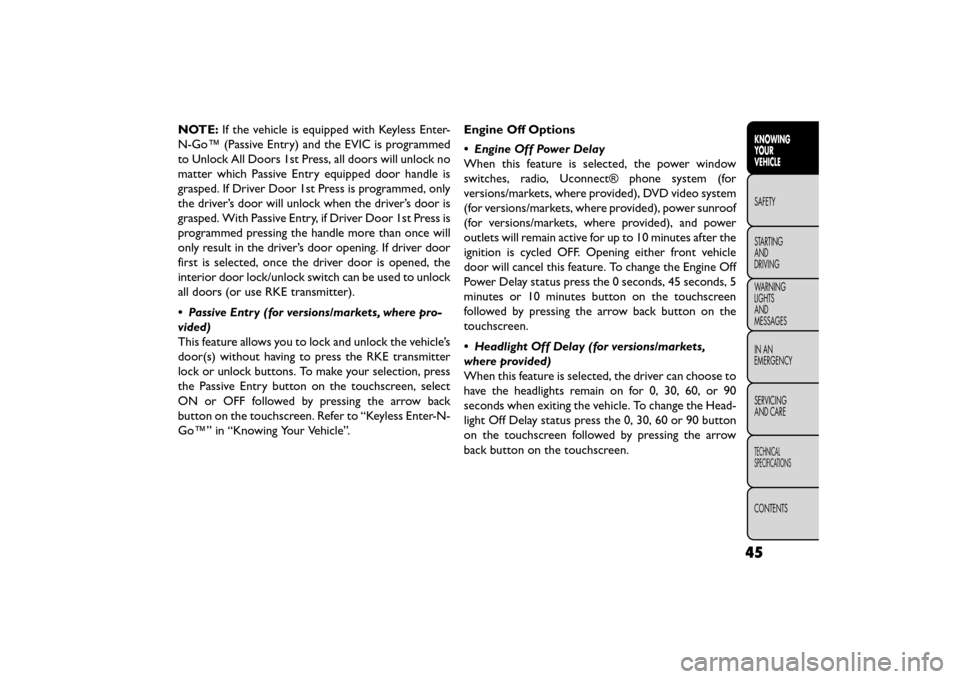
NOTE:If the vehicle is equipped with Keyless Enter-
N-Go™ (Passive Entry) and the EVIC is programmed
to Unlock All Doors 1st Press, all doors will unlock no
matter which Passive Entry equipped door handle is
grasped. If Driver Door 1st Press is programmed, only
the driver’s door will unlock when the driver’s door is
grasped. With Passive Entry, if Driver Door 1st Press is
programmed pressing the handle more than once will
only result in the driver’s door opening. If driver door
first is selected, once the driver door is opened, the
interior door lock/unlock switch can be used to unlock
all doors (or use RKE transmitter).
• Passive Entry (for versions/markets, where pro-
vided)
This feature allows you to lock and unlock the vehicle’s
door(s) without having to press the RKE transmitter
lock or unlock buttons. To make your selection, press
the Passive Entry button on the touchscreen, select
ON or OFF followed by pressing the arrow back
button on the touchscreen. Refer to “Keyless Enter-N-
Go™” in “Knowing Your Vehicle”. Engine Off Options
• Engine Off Power Delay
When this feature is selected, the power window
switches, radio, Uconnect® phone system (for
versions/markets, where provided), DVD video system
(for versions/markets, where provided), power sunroof
(for versions/markets, where provided), and power
outlets will remain active for up to 10 minutes after the
ignition is cycled OFF. Opening either front vehicle
door will cancel this feature. To change the Engine Off
Power Delay status press the 0 seconds, 45 seconds, 5
minutes or 10 minutes button on the touchscreen
followed by pressing the arrow back button on the
touchscreen.
• Headlight Off Delay (for versions/markets,
where provided)
When this feature is selected, the driver can choose to
have the headlights remain on for 0, 30, 60, or 90
seconds when exiting the vehicle. To change the Head-
light Off Delay status press the 0, 30, 60 or 90 button
on the touchscreen followed by pressing the arrow
back button on the touchscreen.
45
KNOWING
YOUR
VEHICLE
SAFETY
STAR
TING
AND
DRIVING
WARNING
LIGHTS
AND
MESSAGES
IN AN
EMERGENCY
SERVICING
AND CARE
TECHNICAL
SPECIFICATIONS
CONTENTS
Page 52 of 412
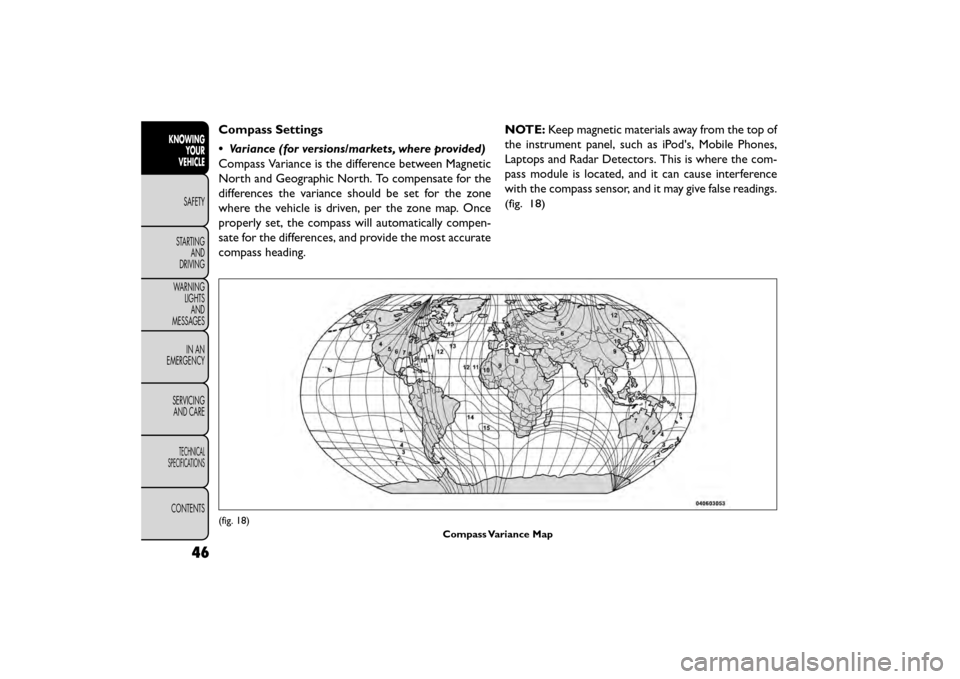
Compass Settings
• Variance (for versions/markets, where provided)
Compass Variance is the difference between Magnetic
North and Geographic North. To compensate for the
differences the variance should be set for the zone
where the vehicle is driven, per the zone map. Once
properly set, the compass will automatically compen-
sate for the differences, and provide the most accurate
compass heading.NOTE:
Keep magnetic materials away from the top of
the instrument panel, such as iPod's, Mobile Phones,
Laptops and Radar Detectors. This is where the com-
pass module is located, and it can cause interference
with the compass sensor, and it may give false readings.
(fig. 18)
(fig. 18)
Compass Variance Map
46
KNOWINGYOUR
VEHICLE
SAFETY
STAR
TINGAND
DRIVING
WARNING LIGHTSAND
MESSAGES
IN AN
EMERGENCY
SERVICINGAND CARE
TECHNICAL
SPECIFICATIONS
CONTENTS
Page 53 of 412
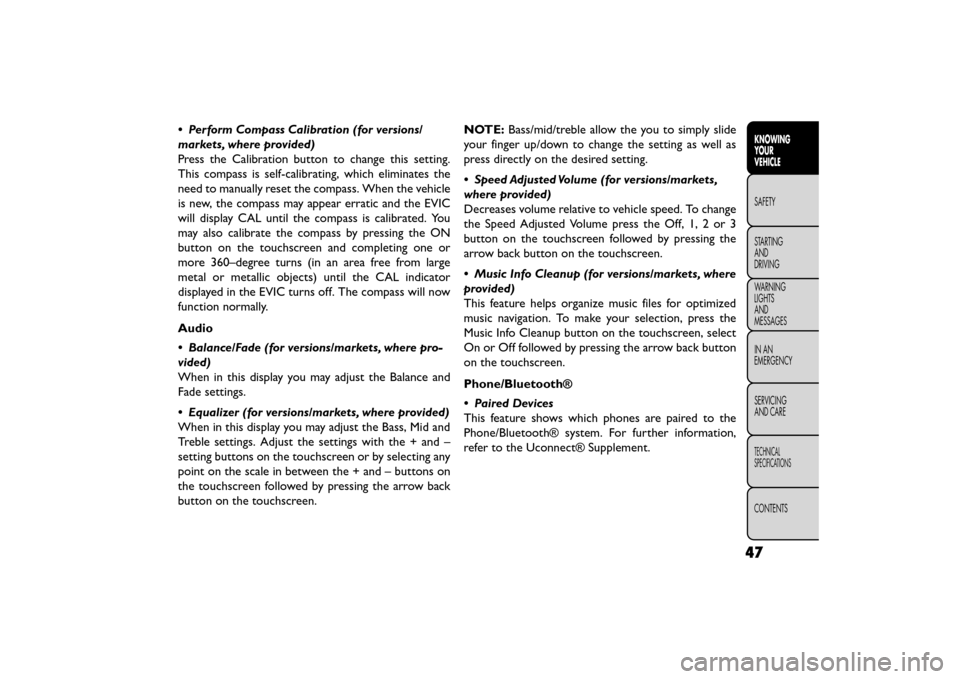
• Perform Compass Calibration (for versions/
markets, where provided)
Press the Calibration button to change this setting.
This compass is self-calibrating, which eliminates the
need to manually reset the compass. When the vehicle
is new, the compass may appear erratic and the EVIC
will display CAL until the compass is calibrated. You
may also calibrate the compass by pressing the ON
button on the touchscreen and completing one or
more 360–degree turns (in an area free from large
metal or metallic objects) until the CAL indicator
displayed in the EVIC turns off. The compass will now
function normally.
Audio
• Balance/Fade (for versions/markets, where pro-
vided)
When in this display you may adjust the Balance and
Fade settings.
• Equalizer (for versions/markets, where provided)
When in this display you may adjust the Bass, Mid and
Treble settings. Adjust the settings with the + and –
setting buttons on the touchscreen or by selecting any
point on the scale in between the + and – buttons on
the touchscreen followed by pressing the arrow back
button on the touchscreen.NOTE:
Bass/mid/treble allow the you to simply slide
your finger up/down to change the setting as well as
press directly on the desired setting.
• Speed Adjusted Volume (for versions/markets,
where provided)
Decreases volume relative to vehicle speed. To change
the Speed Adjusted Volume press the Off, 1, 2 or 3
button on the touchscreen followed by pressing the
arrow back button on the touchscreen.
• Music Info Cleanup (for versions/markets, where
provided)
This feature helps organize music files for optimized
music navigation. To make your selection, press the
Music Info Cleanup button on the touchscreen, select
On or Off followed by pressing the arrow back button
on the touchscreen.
Phone/Bluetooth®
• Paired Devices
This feature shows which phones are paired to the
Phone/Bluetooth® system. For further information,
refer to the Uconnect® Supplement.
47
KNOWING
YOUR
VEHICLE
SAFETY
STAR
TING
AND
DRIVING
WARNING
LIGHTS
AND
MESSAGES
IN AN
EMERGENCY
SERVICING
AND CARE
TECHNICAL
SPECIFICATIONS
CONTENTS
Page 54 of 412
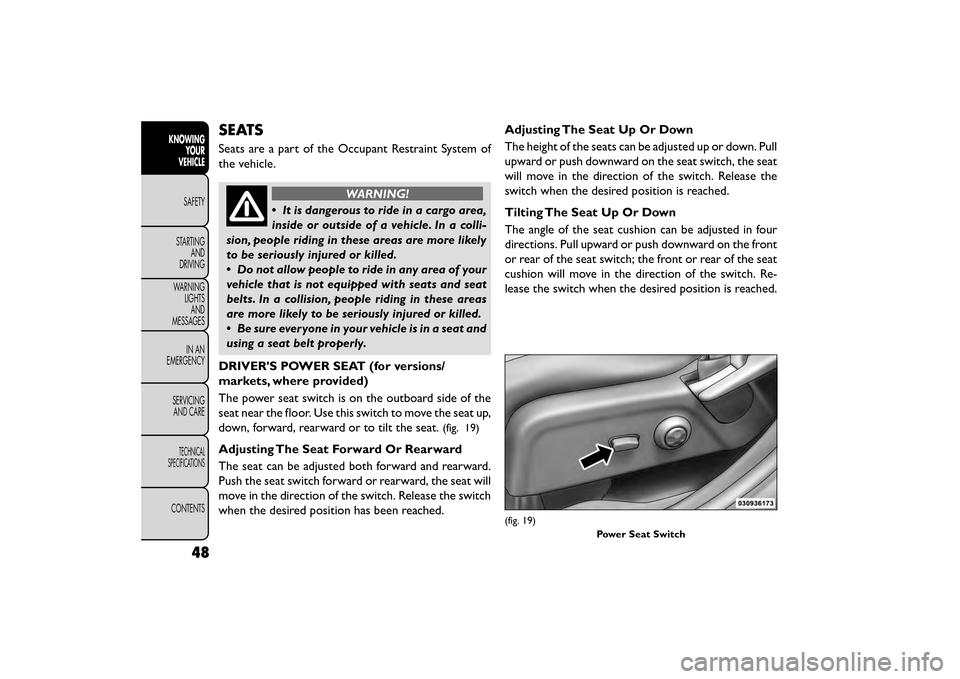
SEATS
Seats are a part of the Occupant Restraint System of
the vehicle.
WARNING!
• It is dangerous to ride in a cargo area,
insi de
or outside of a vehicle. In a colli-
sion, people riding in these areas are more likely
to be seriously injured or killed.
• Do not allow people to ride in any area of your
vehicle that is not equipped with seats and seat
belts. In a collision, people riding in these areas
are more likely to be seriously injured or killed.
• Be sure everyone in your vehicle is in a seat and
using a seat belt properly.
DRIVER'S POWER SEAT (for versions/
markets, where provided)
The power seat switch is on the outboard side of the
seat near the floor. Use this switch to move the seat up,
down, forward, rearward or to tilt the seat.
(fig. 19)
Adjusting The Seat Forward Or Rearward
The seat can be adjusted both forward and rearward.
Push the seat switch forward or rearward, the seat will
move in the direction of the switch. Release the switch
when the desired position has been reached. Adjusting The Seat Up Or Down
The height of the seats can be adjusted up or down. Pull
upward or push downward on the seat switch, the seat
will move in the direction of the switch. Release the
switch when the desired position is reached.
Tilting The Seat Up Or Down
The angle of the seat cushion can be adjusted in four
directions. Pull upward or push downward on the front
or rear of the seat switch; the front or rear of the seat
cushion will move in the direction of the switch. Re-
lease the switch when the desired position is reached.
(fig. 19)
Power Seat Switch
48
KNOWINGYOUR
VEHICLE
SAFETY
STAR
TINGAND
DRIVING
WARNING LIGHTSAND
MESSAGES
IN AN
EMERGENCY
SERVICINGAND CARE
TECHNICAL
SPECIFICATIONS
CONTENTS
Page 55 of 412
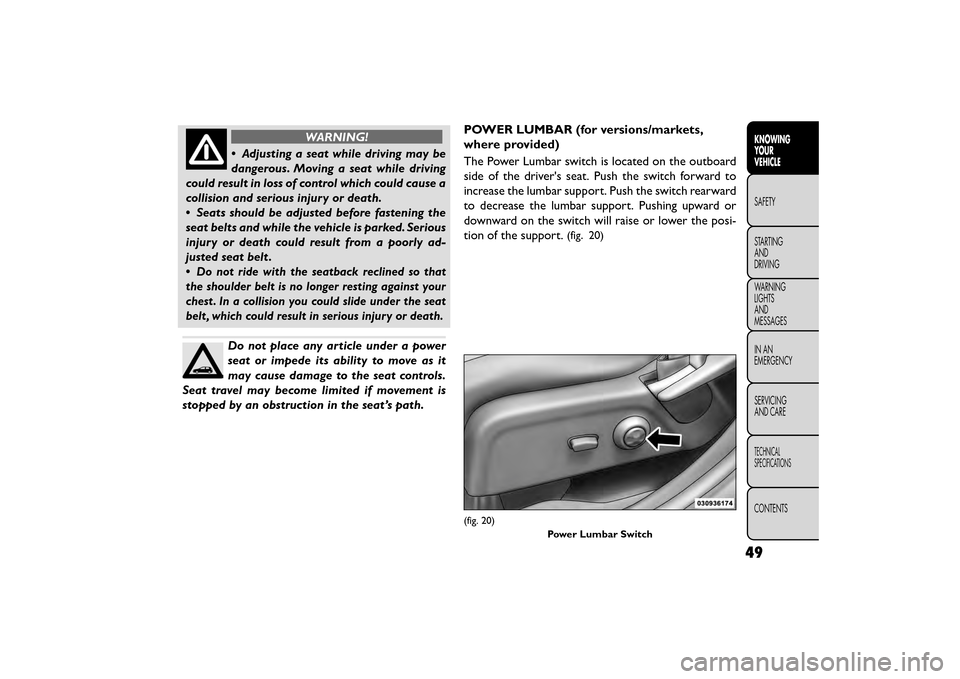
WARNING!
• Adjusting a seat while driving may be
dan gerous
. Moving a seat while driving
could result in loss of control which could cause a
collision and serious injury or death.
• Seats should be adjusted before fastening the
seat belts and while the vehicle is parked. Serious
injury or death could result from a poorly ad-
justed seat belt .
•
Do not ride with the seatback reclined so that
the shoulder belt is no longer resting against your
chest . In a collision you could slide under the seat
belt , which could result in serious injury or death.
Do not place any article under a power
seat or impede its ability to move as it
may cause damage to the seat controls.
Seat travel may become limited if movement is
stopped by an obstruction in the seat’s path. POWER LUMBAR (for versions/markets,
where provided)
The Power Lumbar switch is located on the outboard
side of the driver's seat. Push the switch forward to
increase the lumbar support. Push the switch rearward
to decrease the lumbar support. Pushing upward or
downward on the switch will raise or lower the posi-
tion of the support.
(fig. 20)
(fig. 20)
Power Lumbar Switch
49
KNOWING
YOUR
VEHICLE
SAFETY
STAR
TING
AND
DRIVING
WARNING
LIGHTS
AND
MESSAGES
IN AN
EMERGENCY
SERVICING
AND CARE
TECHNICAL
SPECIFICATIONS
CONTENTS
Page 56 of 412
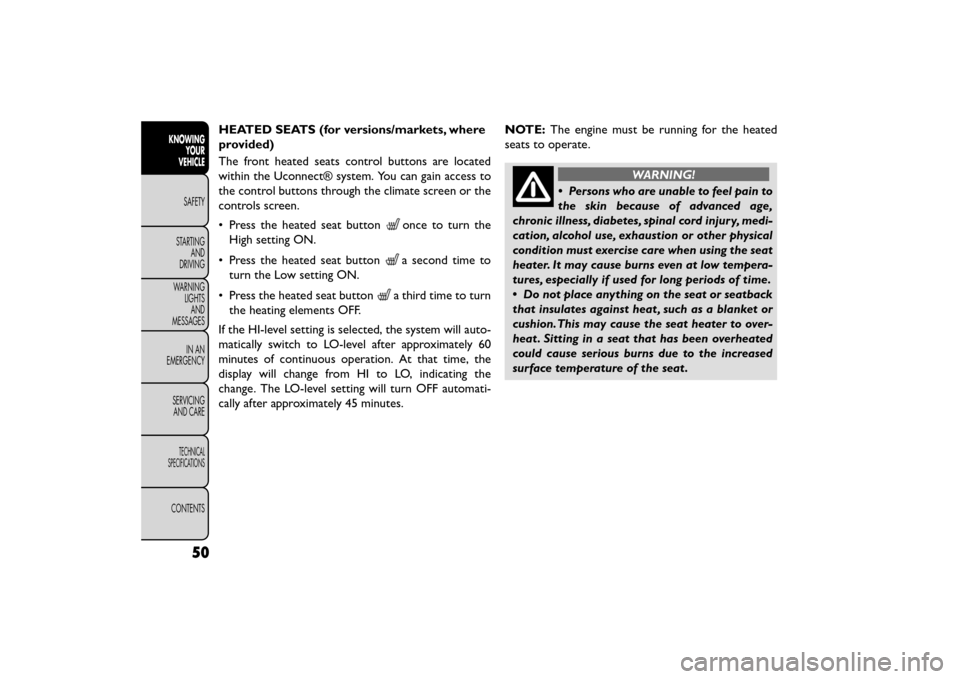
HEATED SEATS (for versions/markets, where
provided)
The front heated seats control buttons are located
within the Uconnect® system. You can gain access to
the control buttons through the climate screen or the
controls screen.
• Press the heated seat button
once to turn the
High setting ON.
• Press the heated seat button
a second time to
turn the Low setting ON.
• Press the heated seat button
a third time to turn
the heating elements OFF.
If the HI-level setting is selected, the system will auto-
matically switch to LO-level after approximately 60
minutes of continuous operation. At that time, the
display will change from HI to LO, indicating the
change. The LO-level setting will turn OFF automati-
cally after approximately 45 minutes. NOTE:
The engine must be running for the heated
seats to operate.
WARNING!
• Persons who are unable to feel pain to
t h
e skin because of advanced age,
chronic illness, diabetes, spinal cord injury, medi-
cation, alcohol use, exhaustion or other physical
condition must exercise care when using the seat
heater. It may cause burns even at low tempera-
tures, especially if used for long periods of time.
• Do not place anything on the seat or seatback
that insulates against heat , such as a blanket or
cushion. This may cause the seat heater to over-
heat . Sitting in a seat that has been overheated
could cause serious burns due to the increased
surface temperature of the seat .
50
KNOWING YOUR
VEHICLE
SAFETY
STAR
TINGAND
DRIVING
WARNING LIGHTSAND
MESSAGES
IN AN
EMERGENCY
SERVICINGAND CARE
TECHNICAL
SPECIFICATIONS
CONTENTS
Page 57 of 412
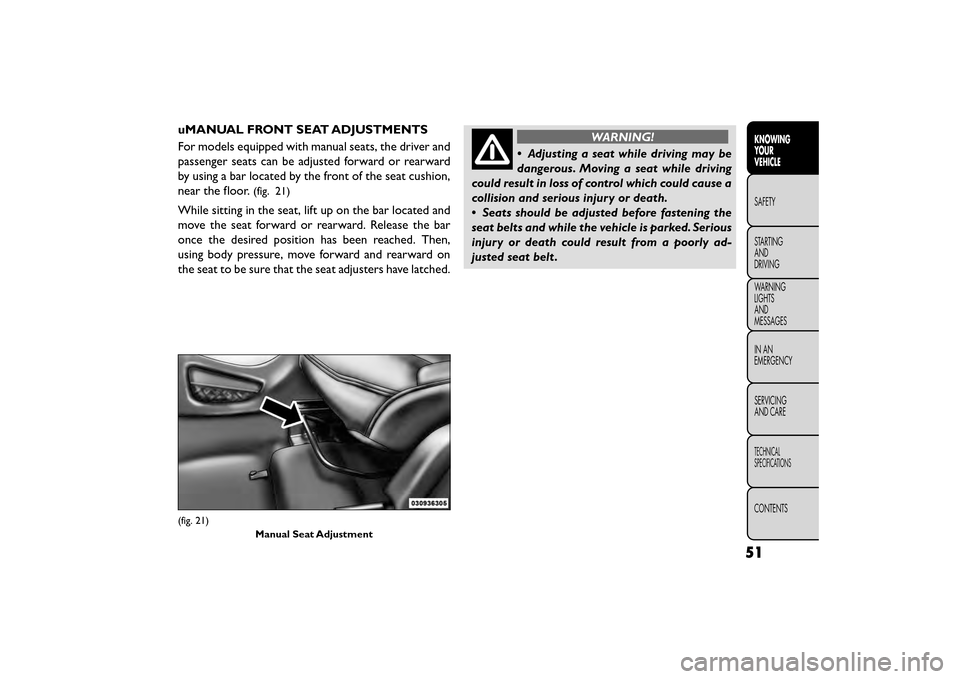
uMANUAL FRONT SEAT ADJUSTMENTS
For models equipped with manual seats, the driver and
passenger seats can be adjusted forward or rearward
by using a bar located by the front of the seat cushion,
near the floor.
(fig. 21)
While sitting in the seat, lift up on the bar located and
move the seat forward or rearward. Release the bar
once the desired position has been reached. Then,
using body pressure, move forward and rearward on
the seat to be sure that the seat adjusters have latched.
WARNING!
• Adjusting a seat while driving may be
dan gerous
. Moving a seat while driving
could result in loss of control which could cause a
collision and serious injury or death.
• Seats should be adjusted before fastening the
seat belts and while the vehicle is parked. Serious
injury or death could result from a poorly ad-
justed seat belt .
(fig. 21)
Manual Seat Adjustment
51
KNOWING
YOUR
VEHICLE
SAFETY
STAR
TING
AND
DRIVING
WARNING
LIGHTS
AND
MESSAGES
IN AN
EMERGENCY
SERVICING
AND CARE
TECHNICAL
SPECIFICATIONS
CONTENTS
Page 58 of 412
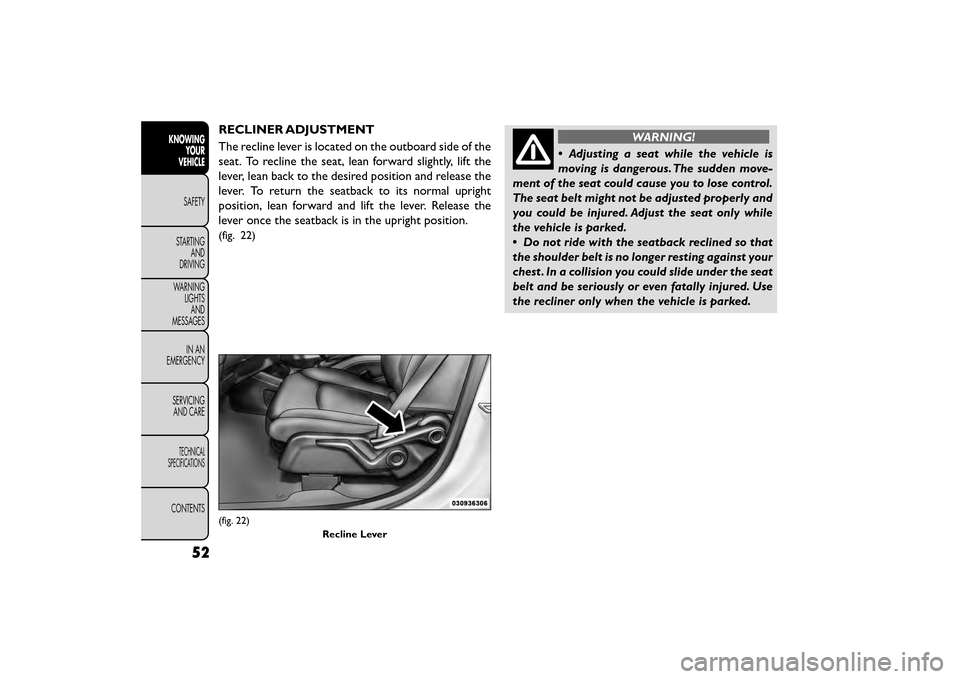
RECLINER ADJUSTMENT
The recline lever is located on the outboard side of the
seat. To recline the seat, lean forward slightly, lift the
lever, lean back to the desired position and release the
lever. To return the seatback to its normal upright
position, lean forward and lift the lever. Release the
lever once the seatback is in the upright position.
(fig. 22)
WARNING!
• Adjusting a seat while the vehicle is
m o
ving is dangerous. The sudden move-
ment of the seat could cause you to lose control.
The seat belt might not be adjusted properly and
you could be injured. Adjust the seat only while
the vehicle is parked.
• Do not ride with the seatback reclined so that
the shoulder belt is no longer resting against your
chest . In a collision you could slide under the seat
belt and be seriously or even fatally injured. Use
the recliner only when the vehicle is parked.
(fig. 22)
Recline Lever
52
KNOWINGYOUR
VEHICLE
SAFETY
STAR
TINGAND
DRIVING
WARNING LIGHTSAND
MESSAGES
IN AN
EMERGENCY
SERVICINGAND CARE
TECHNICAL
SPECIFICATIONS
CONTENTS
Page 59 of 412
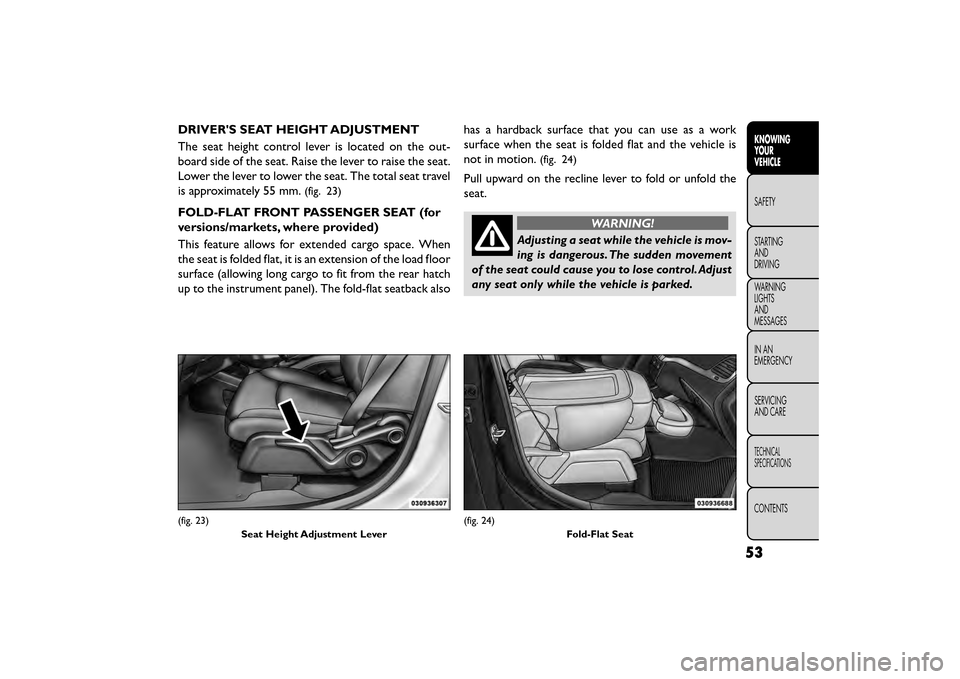
DRIVER'S SEAT HEIGHT ADJUSTMENT
The seat height control lever is located on the out-
board side of the seat. Raise the lever to raise the seat.
Lower the lever to lower the seat. The total seat travel
is approximately 55 mm.
(fig. 23)
FOLD-FLAT FRONT PASSENGER SEAT (for
versions/markets, where provided)
This feature allows for extended cargo space. When
the seat is folded flat, it is an extension of the load floor
surface (allowing long cargo to fit from the rear hatch
up to the instrument panel). The fold-flat seatback alsohas a hardback surface that you can use as a work
surface when the seat is folded flat and the vehicle is
not in motion.
(fig. 24)
Pull upward on the recline lever to fold or unfold the
seat.
WARNING!
Adjusting a seat while the vehicle is mov-
ing is
dangerous. The sudden movement
of the seat could cause you to lose control. Adjust
any seat only while the vehicle is parked.
(fig. 23)
Seat Height Adjustment Lever(fig. 24) Fold-Flat Seat
53
KNOWING
YOUR
VEHICLE
SAFETY
STAR
TING
AND
DRIVING
WARNING
LIGHTS
AND
MESSAGES
IN AN
EMERGENCY
SERVICING
AND CARE
TECHNICAL
SPECIFICATIONS
CONTENTS
Page 60 of 412
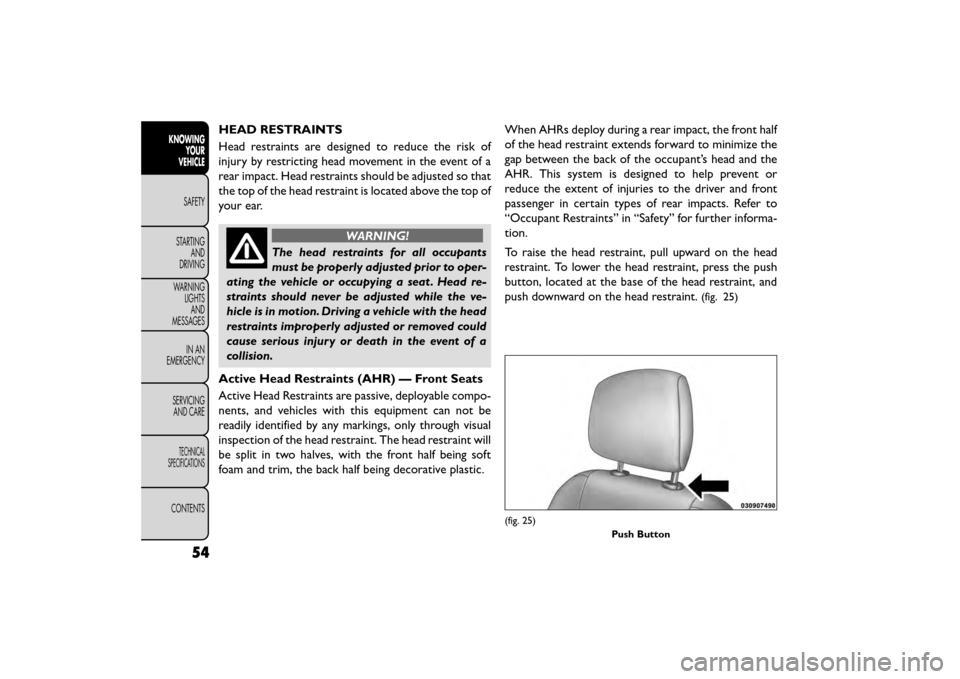
HEAD RESTRAINTS
Head restraints are designed to reduce the risk of
injury by restricting head movement in the event of a
rear impact. Head restraints should be adjusted so that
the top of the head restraint is located above the top of
your ear.
WARNING!
The head restraints for all occupants
mus t
be properly adjusted prior to oper-
ating the vehicle or occupying a seat . Head re-
straints should never be adjusted while the ve-
hicle is in motion. Driving a vehicle with the head
restraints improperly adjusted or removed could
cause serious injury or death in the event of a
collision.
Active Head Restraints (AHR) — Front Seats
Active Head Restraints are passive, deployable compo-
nents, and vehicles with this equipment can not be
readily identified by any markings, only through visual
inspection of the head restraint. The head restraint will
be split in two halves, with the front half being soft
foam and trim, the back half being decorative plastic. When AHRs deploy during a rear impact, the front half
of the head restraint extends forward to minimize the
gap between the back of the occupant’s head and the
AHR. This system is designed to help prevent or
reduce the extent of injuries to the driver and front
passenger in certain types of rear impacts. Refer to
“Occupant Restraints” in “Safety” for further informa-
tion.
To raise the head restraint, pull upward on the head
restraint. To lower the head restraint, press the push
button, located at the base of the head restraint, and
push downward on the head restraint.
(fig. 25)
(fig. 25)
Push Button
54
KNOWINGYOUR
VEHICLE
SAFETY
STAR
TINGAND
DRIVING
WARNING LIGHTSAND
MESSAGES
IN AN
EMERGENCY
SERVICINGAND CARE
TECHNICAL
SPECIFICATIONS
CONTENTS